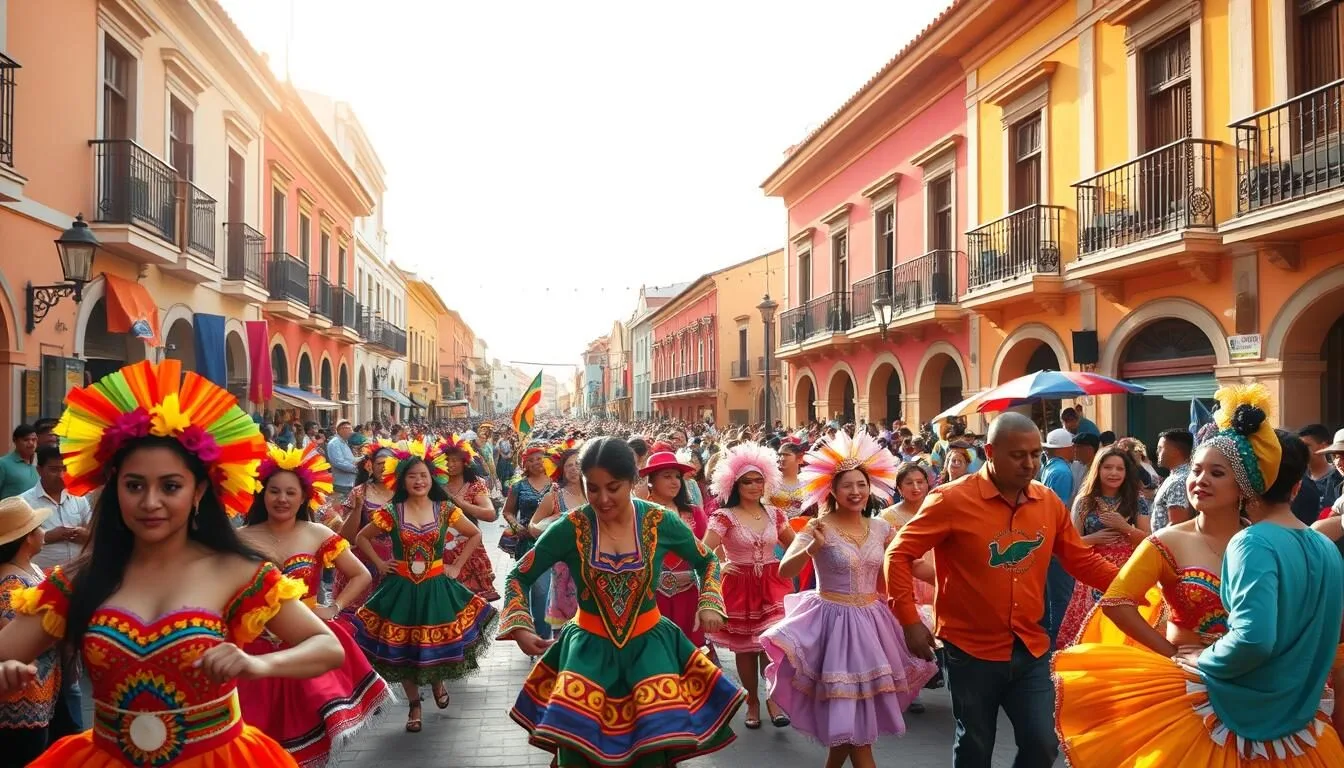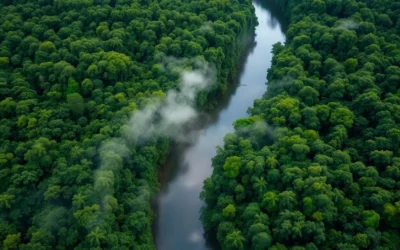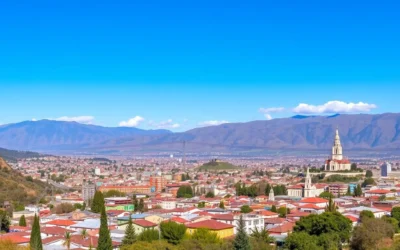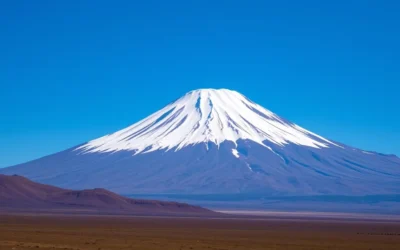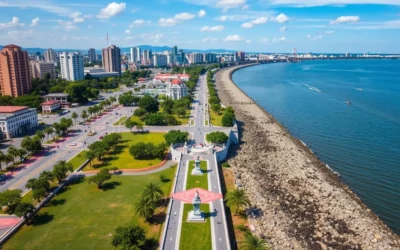✓ Accommodations✓ Flights✓ Rental Cars✓ Tours & Activities
Did you know that Ecuadorians never need much of an excuse for a party, and tourists are often welcome to join in the fun? Across the calendar year, there are many special dates that mark noteworthy celebrations.
These festivals showcase the country’s rich cultural heritage and traditions, ranging from religious ceremonies with Andean symbols to indigenous festivities marking agricultural seasons and historical events.
As you plan your visit, you’ll have the opportunity to witness colorful parades, traditional dances, and authentic music, as well as taste local specialties prepared only for specific festivals. This comprehensive guide will walk you through Ecuador’s festival calendar, helping you coincide your visit with these unforgettable cultural experiences.
Discovering Ecuador Through Its Vibrant Festivals
As you explore Ecuador, you’ll discover a vibrant festival scene that showcases the nation’s diverse traditions and rich cultural heritage. Ecuador’s festivals are an integral part of the country’s identity, blending indigenous Andean customs with Spanish colonial influences.
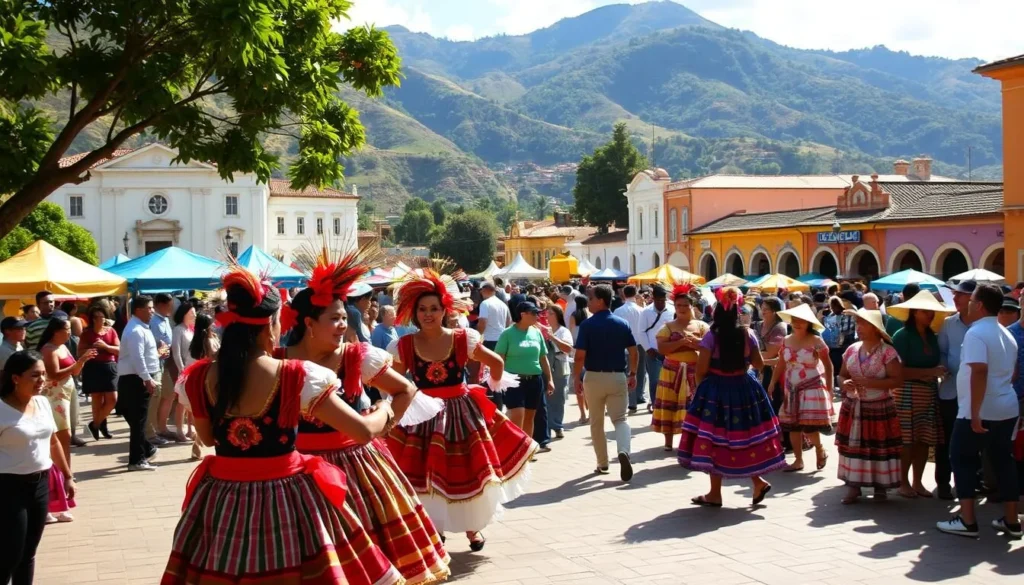
The Cultural Significance of Ecuadorian Celebrations
Ecuador’s festivals represent a fascinating blend of indigenous and Spanish influences, creating a unique cultural tapestry. These celebrations serve as living museums, preserving ancient customs while evolving with contemporary Ecuadorian society. Many festivals mark important agricultural cycles, religious observances, or historical events that shaped the nation’s identity.
What to Expect When Attending an Ecuadorian Festival
When attending an Ecuadorian festival, prepare for a sensory overload of vibrant colors, pulsating music, elaborate costumes, and enticing aromas of traditional foods. You’ll likely encounter traditional music played by Bandas de Pueblo (town bands), featuring distinctive Andean instruments. Most celebrations include traditional dancing, often with participants wearing elaborate costumes representing historical or mythological figures.
Ecuador: Top Festivals to Check Out When Visiting in January and February
Ecuador’s festival calendar kicks off with a bang in January and February, offering visitors a chance to experience the country’s rich heritage. During these months, you can participate in vibrant celebrations that take place across the country, showcasing the unique cultural traditions of Ecuador.
Diablada de Pillaro
The Diablada de Pillaro is a unique festival that take place in the small Andean town of Pillaro from January 1-6. This celebration originated in colonial times as a form of indigenous resistance to Spanish rule, with locals dressing up as devils to mock Catholic priests. You can enjoy six days of wild partying with local dancers in spectacular devil costumes, dancing through the streets.
Three Kings Day – Día de los Reyes
On January 6, Ecuador celebrates the day of the Epiphany with the Three Kings Festival. Processions featuring the Three Kings on horseback take place on the streets of many Andean towns, accompanied by traditional music and festivities. Families gather to enjoy Rosca de Reyes, a special sweet bread sold in bakeries specifically for this celebration.
Carnival
February or March brings Carnival, Ecuador’s version of Mardi Gras, which is a final celebration before Lent. You can expect vibrant parades and participatory festivities, including water fights, foam spraying, and even flour and egg throwing. The towns of Guaranda, Guamote, and Cuenca are known for their particularly enthusiastic celebrations.
Spring Celebrations: March and April Festivals
Spring in Ecuador is a time of colorful celebrations and deep-rooted traditions. As the country transitions from winter to spring, you’re invited to experience the vibrant cultural heritage of Ecuador through its festivals.
Pawkar Raymi – Spring Equinox
Pawkar Raymi, celebrated on March 21st, is an indigenous festival honoring the flowering of crops and giving thanks to Pacha Mama (Mother Earth). This colorful celebration features traditional music, dance, and feasting in indigenous communities across the highlands.
Holy Week (Semana Santa) & Easter
Holy Week, or Semana Santa, takes place in March or April and is one of Ecuador’s most significant religious observances. The week-long celebration includes important processions and masses held across the capital, Quito. The highlight is the Procesión Jesús del Gran Poder, featuring thousands of participants in a solemn procession.
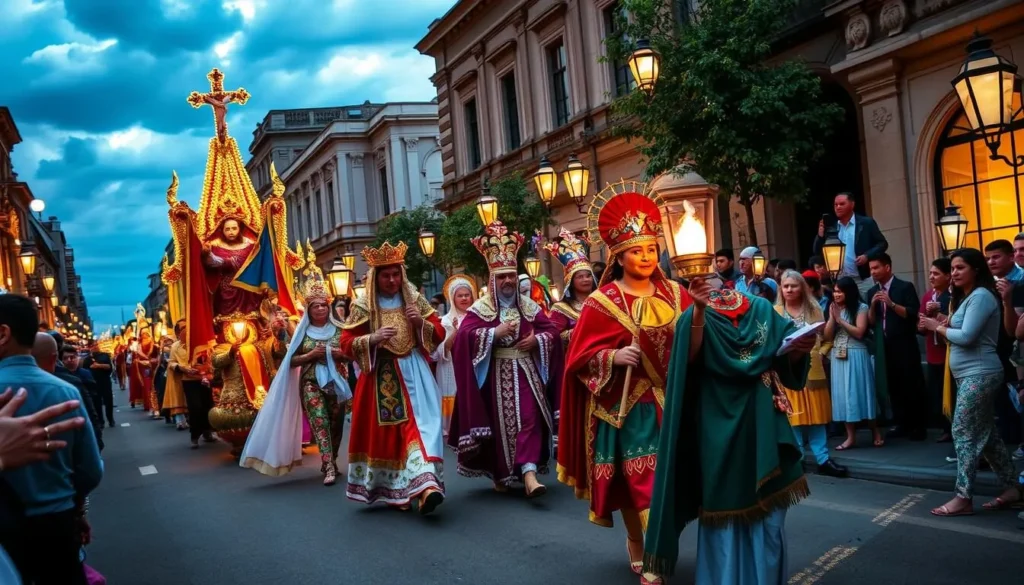
Fanesca: Ecuador’s Special Easter Soup
Easter in Ecuador combines religious observances with unique culinary traditions, most notably Fanesca, a special soup prepared only during this holiday. Fanesca contains 12 beans and grains, symbolizing the apostles, and salt cod, symbolizing Christ, along with various vegetables.
These spring celebrations offer you a profound glimpse into Ecuador’s deep Catholic heritage and its blend with indigenous traditions over centuries. Whether you’re in Quito or exploring other cities, each festival provides a unique cultural experience.
May Festivals: Commemorating History and Tradition
In Ecuador, May is a month of great historical and cultural importance, highlighted by two major festivals. The country comes alive with commemorations and celebrations that blend history and tradition.
Battle of Pichincha
The Battle of Pichincha, commemorated on May 24, is a pivotal event in Ecuador’s history. It marks the victory that led to the country’s independence from Spain in 1822. This decisive battle took place on the slopes of Pichincha volcano above Quito.
Today, the battle is remembered with military parades, cultural events, and a national holiday observed throughout Ecuador. Visitors can experience the celebration at Quito’s Cima de la Libertad, a monument and museum built at the site of the historic battle.
Corpus Christi Festival
Coincidentally, May 24 is also the day when many communities celebrate Corpus Christi, creating a unique overlap of historical and religious observances. This festival blends Catholic traditions with indigenous Andean culture, commemorating the Eucharist while incorporating pre-Hispanic elements.
In indigenous communities, Corpus Christi celebrations are particularly colorful, beginning with spectacular spinning fireworks mounted on metal towers called “castillos.” The town of Pujili hosts one of Ecuador’s most famous Corpus Christi celebrations.
Summer Solstice: Inti Raymi and June Celebrations
Inti Raymi, or the Festival of the Sun, is a vital part of Ecuador’s cultural identity, coinciding with the summer solstice. This ancient Inca tradition is a celebration of Taita Inti (Father Sun), honoring his life-giving energy that nurtures crops and sustains communities. The festival’s name comes from the Quechua language, where “Inti” means sun and “Raymi” means celebration, reflecting its pre-Columbian origins.
Inti Raymi – Festival of the Sun
The Inti Raymi festival typically begins with ritual bathing in sacred waterfalls or rivers, believed to cleanse participants spiritually and prepare them for the festivities. The event features distinctive Andean music played on traditional instruments, energetic dancing in colorful costumes, abundant food, and chicha (a fermented corn beverage). These traditions are a testament to the rich cultural heritage of Ecuador’s indigenous communities.
Best Places to Experience Inti Raymi in Ecuador
Some of the best places to experience Inti Raymi include Otavalo, Peguche, Cotacachi, Saraguro, Ingapirca, and Cochasqui. Otavalo is particularly notable, as it offers an authentic experience with indigenous communities maintaining strong cultural traditions. The Inti Raymi takes place on June 21st, marking the summer solstice and the longest day of the year.
July and August: Cowboy Culture and Religious Pilgrimages
In the heart of South America, Ecuador celebrates July and August with festivals that highlight its cowboy culture and deep-rooted religious pilgrimages. You can experience the vibrant Paseo del Chagra Festival in Machachi, a town nestled near the majestic Cotopaxi National Park.
Paseo del Chagra Festival in Machachi
The Paseo del Chagra Festival is a celebration of Ecuador’s cowboy culture, where traditional Chagras wear leather chaps, ponchos, and hats, showcasing their fine horse-riding skills. Local ranches organize colorful floats that parade through Machachi’s streets, accompanied by skilled Chagra riders. The festival culminates in a rodeo where Chagras demonstrate their horsemanship and compete in various skills competitions.
First Cry for Independence
On August 10, Ecuador commemorates the “First Cry for Independence” of 1809, marking a pivotal moment in the country’s journey to freedom. This event sparked the independence movement throughout South America.
Virgen del Cisne Pilgrimage
The Virgen del Cisne Pilgrimage, honoring the patron saint of farmers, is one of Ecuador’s oldest and most significant religious events. The revered statue of the Virgin is carried in a 24-hour procession from her sanctuary near Loja to the city’s cathedral, covering approximately 70 kilometers.
Indigenous Celebrations in September
The month of September brings two major indigenous celebrations in Ecuador, highlighting the country’s diverse cultural landscape. You can experience the rich heritage of Ecuador’s indigenous communities through these vibrant festivals.
Festival of Yamor in Otavalo
The Festival of Yamor takes place in Otavalo, a town famous for its indigenous market. This celebration blends Catholic and indigenous traditions, honoring the Virgin Mary of Monserrat and Pacha Mama (Mother Earth). The highlight is a traditional drink made from seven varieties of corn, symbolizing abundance and agricultural diversity. You can enjoy colorful parades, traditional Andean music performances, and local food specialties.
Killa Raymi – Fall Equinox
September 21st marks Killa Raymi, the feminine Festival of the Moon, coinciding with the fall equinox. This celebration honors the feminine energy of the moon and symbolizes fertility and the preparation of fields for the rainy season. You can witness authentic Killa Raymi celebrations at archaeological sites like Ingapirca near Cuenca and the Cochasqui Pyramid Ruins north of Quito, experiencing the deep connection to the land and traditions.
The Colorful Mama Negra Festival
You can experience the rich cultural heritage of Ecuador through the Mama Negra Festival in Latacunga. This vibrant celebration is held twice a year and is a unique blend of indigenous, Spanish, and African cultural influences.
Origins and Cultural Significance
The Mama Negra Festival, also known as La Santísima Tragedia (The Holy Tragedy), is a significant celebration in honor of the Virgen de la Merced (Virgin of Mercy). According to local legend, the Virgin miraculously stopped an eruption of the Cotopaxi volcano in 1742, saving the town from destruction. The festival incorporates the arrival of African slaves, who were brought to work in local mines around the time of the volcanic event, making it a fascinating display of Ecuador’s diverse cultural heritage.
When and How to Experience Mama Negra
The Mama Negra Festival takes place twice annually in Latacunga, first in late September and again during the week of November 11th. The celebration features Mama Negra, a man dressed in an elaborate black-faced costume, riding through the streets on horseback, spraying milk and water at spectators, and throwing candies to children. The procession includes other distinctive characters, each with symbolic significance. For the best experience, arrive in Latacunga a day before the main parade to witness preparations and secure accommodations.
Day of the Dead and November Celebrations
The month of November is marked by solemn remembrance and vibrant celebrations in Ecuador. You can experience the country’s rich cultural heritage through its unique traditions and festivities.
All Souls Day Traditions
November 2nd is All Souls Day, a day when families across the country gather at cemeteries to honor their deceased loved ones. They bring food, fruit, and flowers, and sometimes live music is played to share the experience between the living and the dead.
Colada Morada and Guaguas de Pan
A traditional Ecuadorian drink, Colada Morada, is prepared during this time. It’s a thick, sweet purple beverage made from tropical fruits, cinnamon, and herbs, served with Guaguas de Pan – sweet bread shaped like baby dolls and decorated with colorful frosting.
Independence of Cuenca
On November 3rd, Cuenca celebrates its Independence Day, creating a four-day holiday weekend. The city’s plazas are filled with fireworks, live bands, and dance performances, showcasing the city’s vibrant culture and patriotic pride.
December Festivities: From Quito to Christmas
Ecuador kicks off December with a bang, thanks to Fiestas de Quito, the capital’s largest and most exciting festival. This week-long celebration commemorates the founding of Quito on December 6, 1534.
Fiestas de Quito
The municipality organizes a full calendar of cultural events throughout the city‘s districts and neighborhoods. You can witness unique local traditions like children racing go-karts down steep cobblestone streets, colorful parades showcasing Ecuador’s diverse cultures, and concerts featuring popular Latin American bands.
Christmas Traditions in Ecuador
Christmas in Ecuador is a family affair celebrated on the night of December 24th. A large meal of turkey and all the fillings is shared, with rice and seasonal vegetables. Gifts are also exchanged, or perhaps a Secret Santa in workplaces. Ecuadorian Christmas is quite a low-key holiday event, with fewer traditions followed compared to most European countries.
As you experience the celebration and music in the city streets, you’ll feel the vibrant energy of Ecuador’s festive spirit.
New Year’s Eve: Ecuador’s Unique End-of-Year Traditions
Ecuador’s end-of-year celebrations are a fascinating mix of old and new, with a dash of humor and creativity. As you experience the country’s New Year’s Eve traditions, you’ll discover a unique blend of culture, community, and festivity.
The Burning of the Año Viejo Effigies
One of the most iconic traditions is the creation and burning of “Años Viejos” (Old Years) – life-sized effigies made of old clothes stuffed with newspaper or sawdust, often wearing masks representing politicians, celebrities, or characters from the year’s notable events. These effigies symbolize the passing year with all its problems and disappointments, and burning them at midnight represents purification and a fresh start for the new year.
Widows and Wills: Quirky New Year’s Customs
In major city like Quito and Guayaquil, men dress up as “viudas” (widows) of the Old Year, playfully blocking streets and asking for small donations from passing vehicles. The donations are used to fund neighborhood New Year’s parties, adding a community-building element to the celebrations. Before burning the effigy, Ecuadorians read aloud the “testament” of the Old Year, listing humorous “bequests” the year leaves behind, often including jokes about local politics and promises for improvement in the coming year. This quirky tradition is just one of the many unique traditions that make Ecuador’s New Year’s Eve celebrations so special.
Tips for Attending Ecuadorian Festivals
If you’re looking for an immersive cultural experience, Ecuador’s festivals are the perfect opportunity to engage with local traditions. As a visitor, it’s essential to be prepared to make the most of your experience.
Packing and Dressing for the Occasion
When attending Ecuadorian festivals, it’s crucial to pack layers for highland events, as temperatures can fluctuate significantly between day and night. Comfortable walking shoes are also a must, as many festivals involve parades and navigating crowded streets. For water-heavy celebrations like Carnival, consider bringing quick-dry clothing and a waterproof bag to protect your belongings.
Cultural Etiquette and Safety
Respect local customs by dressing modestly when attending religious events. Always ask permission before photographing individuals, especially in indigenous communities. Be mindful of your belongings in crowded festival settings, and consider using a money belt or secure cross-body bag.
Planning Your Trip
Research festival dates in advance, as many celebrations follow religious or agricultural calendars that can vary from year to year. Book your accommodations early, as hotels and guesthouses in festival locations can fill up quickly. Plan for limited services during major festivals, and carry small denominations of cash, as credit cards may not be accepted at all vendors.
| Festival | Date | Location |
|---|---|---|
| Carnival | February/March | Various cities |
| Inti Raymi | June 21 | Otavalo |
| Mama Negra | September | Latacunga |
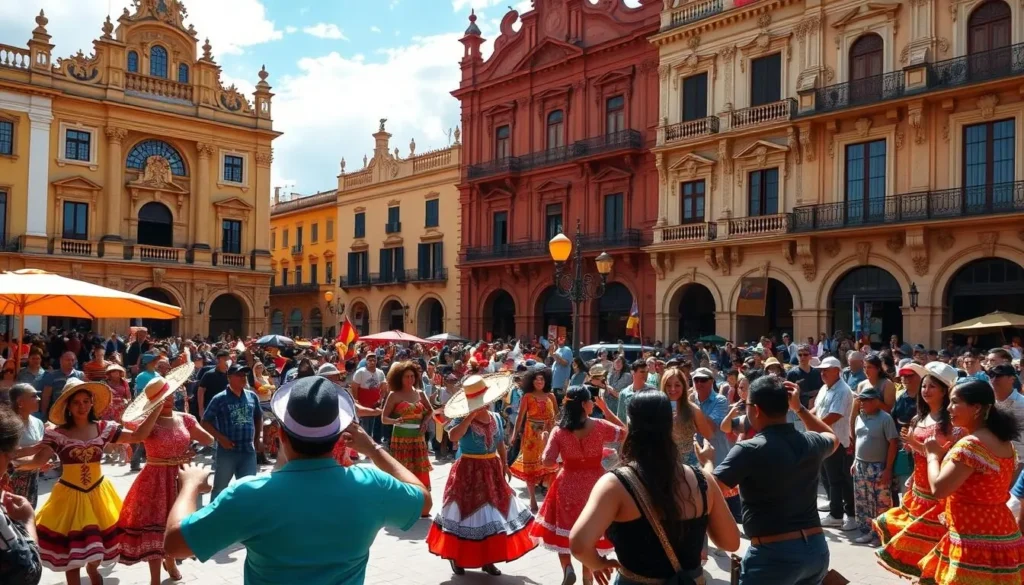
Conclusion: Experiencing the Heart of Ecuador Through Its Festivals
Ecuador’s rich cultural heritage is beautifully reflected in the variety of festivals that take place across the country throughout the year. As visitors, you’re invited to participate in these vibrant celebrations, experiencing the unique blend of indigenous heritage and Spanish colonial influence that defines Ecuadorian identity.
By joining in the events in different places and cities, you’ll gain a deeper understanding of the country’s soul. Whether it’s the devil dancers of Pillaro or the sun worshippers at Inti Raymi, these experiences will become the highlights of your Ecuadorian journey, leaving you with lasting memories of the warmth and hospitality of the Ecuadorian people.
—
The above is subject to change.
Check back often to TRAVEL.COM for the latest travel tips and deals.
